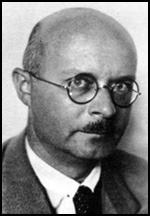Walter Stoecker

Walter Stoecker, the son of an engineer, was born in Colone, Germany, on 9th April 1891. He worked in journalism before serving in the German Army during the First World War.
After the war he joined the Independent Socialist Party and as a member of the Cologne workers' and soldiers' council took part in the failed German Revolution. He later joined the German Communist Party (KPD) and became co-editor of its newspaper, Kommunistische Rundschau. He also served as a member of the central committee and was one of the leaders of the KPD in the Reichstag.
On 27th February, 1933, someone set fire to the Reichstag. Several people were arrested including a leading, Georgi Dimitrov, general secretary of the Comintern, the international communist organization. Dimitrov was eventually acquitted but a young man from the Netherlands, Marianus van der Lubbe, was eventually executed for the crime. As a teenager Lubbe had been a communist and Hermann Goering used this information to claim that the Reichstag Fire was part of a KPD plot to overthrow the government.
Adolf Hitler gave orders that all leaders of the German Communist Party (KPD) should "be hanged that very night." Paul von Hindenburg vetoed this decision but did agree that Hitler should take "dictatorial powers". KPD candidates in the election were arrested and Goering announced that the Nazi Party planned "to exterminate" German communists. Stoecker, like thousands of other left-wing politicians, were arrested and sent to Germany's first concentration camp at Dachau, a village a few miles from Munich.
Walter Stoecker was later moved to Buchenwald Concentration Camp, where he died on 10th March, 1939. A fellow inmate, Hasso Grabner, said "the camp was like an orphaned child whose beloved father has died".
Primary Sources
(1) Hermann Langbein, Against All Hope: Resistance in the Nazi Concentration Camps 1938-1945 (1992)
National Socialism replaced democratic institutions with a system of command and obedience, the so-called Fuhrer principle, and it was this system that the Nazis installed in their concentration camps. It goes without saying that any command by a member of the SS had to be unconditionally carried out by all prisoners. Refusal or hesitation was liable to lead to a cruel death. The camp administration not only saw to it that every command was carried out, but also held inmates assigned to certain jobs responsible for completing them. In this way it facilitated its own work and was also able to play one prisoner off against another. This system was already working when the first foreigners arrived at the camps in 1938. Each unit housing prisoners, whether a barrack or a brick building, was called a block. The camp administration held a senior block inmate (Blockdltester) responsible for enforcing discipline, keeping order, and carrying out all commands. If a dwelling unit was divided into rooms, a senior block inmate was assisted by senior barracks inmates and their staff. A senior camp inmate (Lageraltester) was responsible for the operation of the entire camp, and it was he who proposed the appointment of senior block inmates to the officer-in-charge. After the expansion of the camps, several senior camp inmates were appointed in a number of the camps, and they divided the tasks among them. Each labor detail was headed by a capo (trusty), and if the size of the detail required it, he had assistant capos or foremen under him. The capo himself was exempted from work, but he had to see to it that the required work was done by his underlings. Capos, senior block inmates, and senior camp inmates were identified by an armband with the appropriate inscription. These armband wearers, as they were generally called, were under the protection of the camp administration, often enjoyed extensive privileges, and as a rule had unlimited power over those under them. This is to be taken literally, for if an armband wearer killed an underling, he did not (with a few exceptions) have to answer to anyone, provided a timely report of the death was made and the roll call was corrected. An ordinary prisoner was completely at the mercy of his capo and senior block inmate.
As a rule the SS bestowed armbands on prisoners they could expect to be willing tools in return for their privileged status. As soon as German convicts arrived in the camps-that is, before 1938 - the SS preferred them to morally stable men. Thus, having been despised as outsiders by society all their lives, they now wielded immense power over others by virtue of a simple armband. If one of these men earned the hatred of his fellow prisoners by misusing this power, he was utterly at the mercy of the SS, for armband wearers with blood on their hands, once they lost their jobs and thus the protection of the SS, were fair game for a vengeful camp. A number of fallen capos were gang-murdered...
With years of practice behind them, many camp commandants were virtuosos at running this system. Since it was aimed at completely destroying the human dignity of anti-Nazis, a hardened criminal was able to order an anti-Nazi around as he saw fit. Such people were at the criminal's mercy when there was no SS man in the camp. Anyone who wanted to fight this system had to reduce or, if possible, abolish the effectiveness of this Fuhrer principle, as it applied to the inmates. Occasionally even some SS leaders assisted in this endeavor.
On a number of occasions, commandants and officers-in-charge could be persuaded to entrust the self-government of the inmates to prisoners without a criminal past. On the basis of his experiences in Buchenwald, Walter Poller writes: "Even some SS henchmen in the concentration camp who tried very hard to treat political prisoners in accordance with instructions could not conceal the fact that this demand of their leadership and ideology (that is, to assess political offenses as criminal ones).
